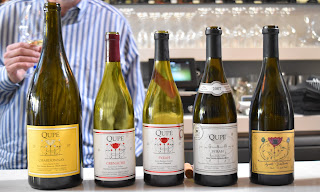Sherry is a fortified wine from Jerez, Spain.
Sherry wines are matured in a system called solera system, and undergo biological or oxidative ageing.
In biological ageing, wines are fortified to around 15% abv. At this alcohol level, a layer of yeast called flor is developed on the surface. Flor protects wine from air and also gives distinctive bready quality.
Fino and Manzanilla are made this way.
In oxidative ageing, wines are fortified to 17% abv which prevents the development of flor.
Oloroso sherry goes through oxidative ageing and has flavors of roasted nut, coffee or meat as a result of oxidation.
Amontillado undergoes oxidative ageing after biological ageing.
La Guita Manzanilla
Dried white fruit and fresh grass.
This wine had an impression of more freshness than tanginess or saltiness which is distinct flavor of Fino or Manzanilla.
We had this wine paired with Gildas (classic Basque Pintxo: Boqueron anchovy, Piparra pepper and olive).
Hidalgo el Tresillo Amontillado
Sultana and biscuit. There was freshness, almost like pyrazine.
This wine was paired with Embutidos (mixed plate with Spanish cheese, meats and nuts) and ratatouille.


Hidalgo Villapanes Oloroso
Sweet baking spice, raisin, nut and coffee.
The pairing was with Carillada de Cerdo (pork stew) with Alubia Granja Beans.
Delicious stew from grandma's recipe.
Morenita Cream
Dried fruit, citrus peel and coffee. Not too sweet.
We had this with Dates stuffed with Goat Cheese and Walnuts.
Hidalgo Pedro Ximenez
Cherry, prune, raisin and coffee. There were dried fruit quality and freshness at the same time.
Pouring this on top of vanilla bean ice cream. Delicious.
Good wines and good pairing.
Sherry is not necessarily my favorite type of wine therefore I don't drink them often, so an event like this gives me a chance to open my eyes to something I am prejudiced otherwise.






























